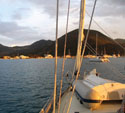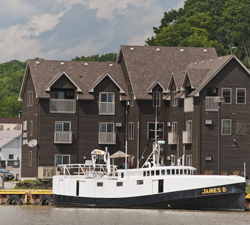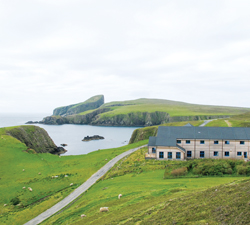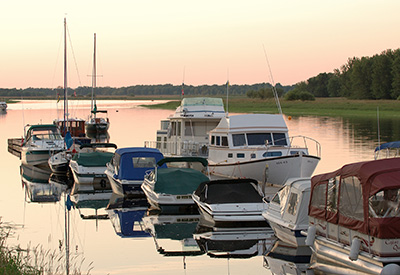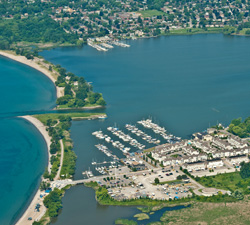Voyage to the Baltic Sea

Paul and I had always wanted to sail to the countries of Scandinavia so, following a successful shake-down cruise to the Channel Islands and along the south coast of England last spring, we pointed the bows of our new Southerly 49 variable-draft sailboat, Distant Shores II, towards the Baltic Sea.
The Route
Our 3,200 nm summer voyage to the Baltic would take us from Chichester Harbour in England across the North Sea with stops in Holland and Germany then through the Kiel Canal into the Baltic Sea to explore Denmark and Sweden, then back to England to the Northshore Shipyard in Chichester Habour where Southerly yachts are built. We planned the voyage as a loop so that, if necessary, any snags or warranty issues that might arise during the voyage could be dealt with while we and the boat were still in Europe.
The Climate
The sailing season in the Baltic Sea is pretty much the same as on the Great Lakes. The spring and fall weather is cool but in the middle of the summer you can get “shorts and t-shirt” temperatures. However, in Denmark and Sweden the children go back to school in mid-August so many marinas, restaurants, and other related support facilities for boaters start to close down (even though the weather is still pleasant for sailing by our standards). We quickly learned that it's just not part of the mind-set to be out sailing in later summer and September, let alone October, in Scandinavia but a little further south in Germany, Holland, and England, everyone was still out there in the late autumn.
Why Go There?
What was the appeal of cruising to countries of Scandinavia? We've always felt that, due to the climate, we as Canadians have a lot in common with the lifestyle and the people of Scandinavia and knew we would feel comfortable there (which we did). Both Paul and I have a keen interest in the Viking and seafaring history of Scandinavia and had read about lots of Viking festivals, fairs, and museums we could visit by boat. How cool is that, maritime history lovers?
In Scandinavia, everyone learns English in school and pretty much everyone speaks it fluently. Our route to the Baltic included Holland where English is also spoken fluently, a little less so in Germany, but Paul's not bad with German. (We had just spent many seasons cruising in the Mediterranean and Middle East, but there's always a language barrier to deal with which can be wearing at times. And although we worked hard to learn many languages we never got good enough at any of them to be able to have truly in-depth conversations with the locals.) Talking to people about their lives, opinions and attitudes is something that we find enriching about travelling. It helps you broaden your horizons and challenges your perspectives on things.
We chose to start with the Scandinavian countries bordering the Baltic Sea – Denmark and Sweden and, if we had time, Finland – since the Baltic is a gentle sea. There is hardly any tide, the sea is not very salty. (I know, I know, we 're freshwater sailors at heart). There are fewer gales here than in other bodies of water in Northern Europe, and the climate in the Baltic is warmer in the summer months than out on the North Sea.
The first leg of our voyage to the Baltic took us along the south coast of England from Chichester Harbour to Brighton Beach and then Ramsgate where we made our jump across the incredibly busy English Channel sailing overnight to Den Helder, our first port in the Netherlands. Our good friend, Wanita Gray, flew in from Canada just before we left Chichester Harbour and joined us for the leg to the Frisian Islands, which lie like a string of pearls along the north coast of Holland and Germany.
Holland – The Frisian Islands
In Den Helder, we exchanged our British pound notes for euros and enjoyed a day browsing the town, relaxing in cafes, sampling amazing Dutch cheeses, and getting a feel for the country and culture. The town was spotlessly clean and orderly and everyone, it seemed, was riding bicycles. In fact, everywhere we went in Holland offered up excellent bike paths. You could rent them everywhere and it was a fun way to get some exercise and to explore the towns and villages we stopped at.
From Den Helder, we made an afternoon sail to the island of Texel where we entered the shallow Wadden Sea, the body of water between the Frisian Islands and the mainland. The Frisian Islands are a cruising paradise for boats with shallow-draft capabilities. Although Distant Shores II is 49 feet long she only draws 2' 10" with the keel up (10' 3” with the keel down) so depth wasn't an issue in these very shallow seas. We can also retract the keel completely and dry out at low tide, which we often did in remote places.
We had pretty strong winds the next few days but in the protection of the islands the seas are relatively flat, so we had great fun short-tacking up the narrow channels. The next island we visited was Vlieland, a very natural place with lovely, long, golden beaches and sand dunes. From Vlieland, Wanita took the ferry to the mainland where she caught a train to the airport in Amsterdam to head home. It is very easy to do crew changes in these seemingly remote islands due to the excellent and affordable Dutch transportation systems. Later in the summer on our way back to England, a British friend joined us in Holland for a trip through the Dutch Canals. There is a stand-mast route from the Wadden Sea all the way to Amsterdam, which takes you through picturesque and historic little Dutch villages.
Germany and the Kiel Canal – From the North Sea to the Baltic Sea
Next day we sailed to Borkum in the German Frisian Islands and from there sailed offshore, timing our arrival with a positive tide up the Elbe River to the Cuxhaven Sailing Club on the German mainland, a friendly stopover, plus crossroads for international cruising sailors. Cuxhaven was a good place to provision, especially for stocking up on good wines. Alcohol is very expensive in Denmark and Sweden as is dining out in restaurants, so we always carry a good selection of wine during a cruise to share with new friends over home-cooked meals made on board.
Just up-river from Cuxhaven we entered the Kiel Canal of Germany. In German it's called the Nord-Ostee-Kanal and is considered to be the world's busiest artificial waterway. It is the basis for trade between the countries of the Baltic area and the rest of the world. About 43,000 ships pass through the canal annually, not including small craft, so it is a busy place and makes an interesting two-day trip in a sailboat.
The Kiel Canal runs for almost 100 km (about 61 miles) across the Schleswig-Holstein, the northernmost of the 16 states of Germany, which borders Denmark to the north, the North Sea to the west, and the Baltic Sea to the east. It goes from Brunsbüttel to Kiel-Holtenau and links the North Sea with the Baltic. An average of 250 nautical miles will be saved by using the Kiel Canal instead of going around the top of Denmark to the north.
When we popped out of the canal in Kiel two days later there was a tall ship festival going on. Turns out it was the final day of Kiel Week, one of the biggest sailing regattas in the world! Bands were playing, parachutists were dropping out of the sky, and there were hundreds (or so it seemed) of classic boats sailing in the harbour. It was quite an entrance to the Baltic Sea!
From Kiel we had a lovely afternoon sail up to a fjord called the Schlei, our last port in Germany. The anchorage was huge but there were only two other boats there. Meanwhile the marinas in the fjord were packed solid with boats rafted two and three deep! This was a situation we saw repeatedly throughout Scandinavia during the summer. Sailors here do not like to swing at anchor the way we do so we rarely encountered a crowded anchorage even in the high season. Here, everyone is happy to raft-up in marinas so, no matter how crowded they are, everyone is welcome and a space is always found for you.
Denmark – The Southern Islands
From Schlei, we explored Denmark's south Funen archipelago first visiting the small rural island of Lyø where we had a delightful visit to the Maritime Museum in Lyø run by Susi Hansen, a ship's captain's wife, who started this interesting collection in her kitchen and tells wonder seafaring stories to all visitors.
Next stop was Faaborg where we stayed at the marina and learned much about the history of the harbour from enthusiastic marina attendant, Kim Ingerslev, who speaks seven languages and makes every visitor feel at home. There is a great 100-year-old smokehouse at the harbour, Faaborg Fiskehuset, where salmon and herring are smoked in the traditional way – a popular food in Scandinavia.
A real highlight in this region of Denmark is a visit to the island of Æro to the harbours at Æroskobing and Marstel. We stayed at the commercial harbour in Æroskobing and rented a little electric car and drove down to Marstel at the other end of the island to see the excellent maritime museum there. Æroskobing is an historic and picturesque “fairytale” village and we learned much about it from the wonderful nightwatchman tour given every night a 9 o'clock during the summer months.
We returned here a week later after picking up our parents at the airport in Copenhagen who had come for a visit. From Æroskobing we sailed with them along the south and east coasts of Denmark stopping at many small harbours along the way to Copenhagen where we moored in the heart of the city in the Nyhavn canal. From the Nyhavn Canal we could walk to all the city's major attractions and had a couple of culture-filled days visiting museums and palaces.
We sailed on to Sweden where we travelled along the south and east coasts full of delightful islands in extensive archipelagoes. There is a well-established network of guest and natural harbours throughout these archipelagoes and we had a wonderful month of island hopping.
A highlight was sailing to the island of Gotland located in the middle of the Baltic Sea where we attended the annual Medieval Week festivities held in the beautifully preserved medieval port of Visby. Everyone, including members of the press, were required to dress in period costume so we had great fun at the medieval market buying costumes and. It was quite funny to see people getting off the ferry as well as fellow yachties climbing off their boats dressed medieval style! Our costumes evolved over the days we were there attending tournaments, banquets, concerts, fire shows, juggling and jester acts. It was an event-filled week and just so much fun!
Things were much quieter in the nature harbours further north in the forested islands of the Stockholm archipelago. In fact many of the anchorages have wood-burning saunas on shore that you can use! This is wonderful after a bracing day sail. The Archipelago Foundation maintains them and wood, an axe, fire starter, etc. are all supplied. You make a small donation in a box on the honour system. They are kept immaculately clean by the conscientious sailors who enjoy these waters.
When we arrived in Stockholm we met up with Swedish friends, Siv and Christer Johanssen, who we had sailed with in the Caribbean 19 years ago! It was as if no time had passed and they joined us aboard Distant Shores II for a long weekend, taking us to their favourite harbours. We also attended the annual rendezvous of the Swedish Ocean Sailing Club of which they are founding members. Wherever there are sailors, there are good times and good food to be enjoyed together!
Stockholm was the farthest north that we sailed in Sweden but our adventures in Sweden weren't over. Our next cruising experience there was to travel all the way from the Stockholm area on the east coast through the Göta & Trollhätte Canals to Gothenburg on the west coast, a distance of 558 km (347 miles) by the canal route as compared to 950 km (590 miles) if you sail from one to the other on the Baltic. The inland waterway route for the most part connects natural rivers and lakes including Lake Vänern, the third largest lake in Europe, 64 nm to cross. Only 97 km (60 miles) of the whole trans-Sweden route is artificial waterway.
There are a total of 65 locks to negotiate, which we managed with just the two of us on board although it was challenging at times. Having one more person on board would have made it much more manageable but we had a great time and the scenery was lovely! There are many pretty little towns along the route of the Göta Canal with good facilities for yachts. Our favourite guest harbour was on Lake Vättern in the town of Vadstena where you moor your boat in the moat of a castle!
We did the canals in mid-September (just a couple of weeks before the Göta Canal closed for the season) taking seven days to reach Gothenburg. Winter comes early in Sweden! Most of the local boats were hauling out already. Winds increased and the weather turned chilly. However, the waterway is very protected so we felt it was a good trip to do in the autumn to extend the boating season in Sweden.
In Gothenburg, Roger and Kerstin Börjesson, who own a Southerly 110 called Blue Magic, saw our boat in the harbour and invited us to their home for dinner for a traditional Swedish meal and gave us lots of good tips on cruising the west coast of Sweden which we hope to do in the future. This spontaneous Southerly owners get-together was a nice way to finish our Baltic cruise and as the winds of late September started to blow cold we hopped aboard to sail south back to Germany, the Kiel Canal to the North Sea, and through the Dutch Canals out to the English Channel and back to Itchenor for the winter.
Award-winning filmmakers and sailing authors, Paul and Sheryl Shard, have been cruising internationally since 1989. They are the hosts of the sailing adventure TV series, “Distant Shores”, that airs weekdays across Canada at 6PM ET/3PM PT on Travel and Escape Channel and includes episodes on their Baltic cruise. Visit their website at www.distantshores.ca
Navigation Equipment – AIS
One of the new pieces of navigational equipment we installed on Distant Shores II that made watch-keeping a pleasure was an AIS (Automated Information System) transmitter. On our first Southerly, a 42 called Distant Shores, we enjoyed having on AIS receiver which provided lots of information overlaid on our Raymarine chartplotter about the name, size, speed, position and closest point of approach of the ships surrounding us. On Distant Shores II we added the AIS transmitter so that ships and other vessels with receivers can see this information about our boat as well. This proved invaluable in many instances, especially in the heavy ship traffic encountered during the crossing of the English Channel since we could literally see ships changing course around us long before we had to call them about collision avoidance maneouvers. Later in the Göta & Trollhätte Canals in Sweden and on our return trip through the canals of Holland, the lock-keepers would often have the locks ready and open for us before we called
them with our ETA since they saw us approaching on AIS. (Note: There is a privacy feature so you can shut off the transmission if you don't want your information to be seen, for example, in remote areas where piracy could be a threat.)
By Sheryl and Paul Shard

